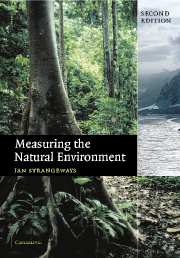Book contents
- Frontmatter
- Contents
- Acknowledgements
- 1 Basics
- 2 Radiation
- 3 Temperature
- 4 Humidity
- 5 Wind
- 6 Barometric pressure
- 7 Evaporation
- 8 Precipitation
- 9 Soil moisture and groundwater
- 10 Rivers and lakes
- 11 Data logging
- 12 Telemetry
- 13 Visibility
- 14 Clouds
- 15 Lightning
- 16 The upper atmosphere
- 17 The oceans
- 18 Cold regions
- 19 Remote sensing
- 20 Atmospheric composition
- 21 Forward look
- Appendix: abbreviations and acronyms
- Index
- References
16 - The upper atmosphere
Published online by Cambridge University Press: 05 July 2014
- Frontmatter
- Contents
- Acknowledgements
- 1 Basics
- 2 Radiation
- 3 Temperature
- 4 Humidity
- 5 Wind
- 6 Barometric pressure
- 7 Evaporation
- 8 Precipitation
- 9 Soil moisture and groundwater
- 10 Rivers and lakes
- 11 Data logging
- 12 Telemetry
- 13 Visibility
- 14 Clouds
- 15 Lightning
- 16 The upper atmosphere
- 17 The oceans
- 18 Cold regions
- 19 Remote sensing
- 20 Atmospheric composition
- 21 Forward look
- Appendix: abbreviations and acronyms
- Index
- References
Summary
At the place where we slept water necessarily boiled, from the diminished pressure of the atmosphere, at a lower temperature than it does in a less lofty country … Hence the potatoes, after remaining for some hours in the boiling water, were nearly as hard as ever. The pot was left on the fire all night, and next morning it was boiled again, but yet the potatoes were not cooked.
Charles Darwin Voyage of the Beagle (high in the Andes).The variables and their history
For use in numerical weather prediction models, for climate change and pollution studies, to predict radio propagation behaviour, for aviation and for the launch of space vehicles, it is necessary to know how conditions change with altitude, in particular temperature, humidity, pressure and wind.
Upper air measurements started around 1650 when Pascal and Perrier carried barometers up a mountain (see Chapter 6). But because of the lack of suitable platforms to carry instruments aloft, there was no further progress until about 1749 when Alexander Wilson made one of the first attempts using a kite, this being followed in 1784 by a balloon flight over Paris, giving the first observation of temperature lapse rate. Balloons and kites developed alongside into the nineteenth century when Gay-Lussac made a balloon ascent to 23 000 feet while in 1865 Glaisher flew to 11 km in a coal gas balloon, almost dying in the process.
- Type
- Chapter
- Information
- Measuring the Natural Environment , pp. 383 - 420Publisher: Cambridge University PressPrint publication year: 2003



